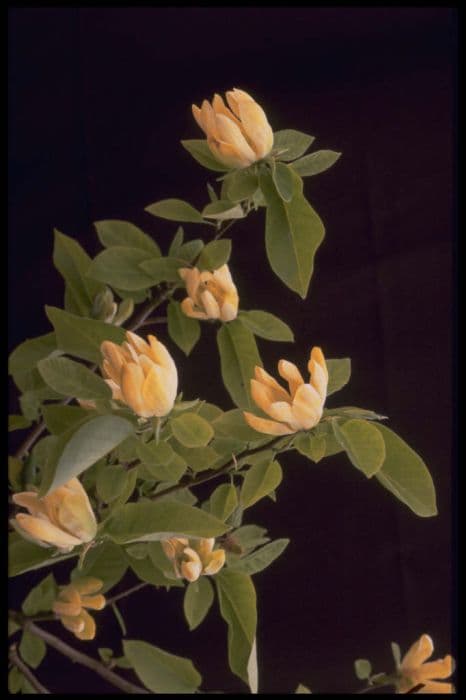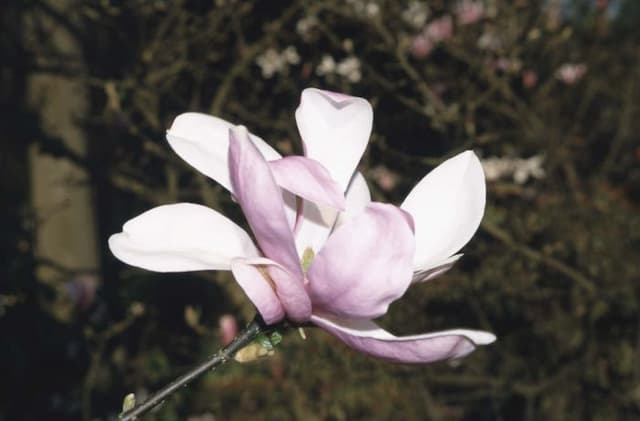Heaven Scent Magnolia Magnolia 'Heaven Scent'

ABOUT
The Magnolia 'Heaven Scent' is a captivating flowering plant that boasts an array of visually striking features. It is notable for its large, tulip-shaped blooms that exude a delightful fragrance reminiscent of tropical fruits, hence the name 'Heaven Scent.' The flowers display a gradient of color, primarily a soft shade of pink at the base, transitioning to a lighter pink or nearly white at the tips, adding to its ethereal beauty. The blossoms of the Heaven Scent magnolia emerge from velvety buds that provide a stark contrast against the foliage before they unfurl. The leaves are oblong with a glossy, deep green color, offering a lush backdrop that further accentuates the vibrant blooms. In the springtime, the plant is particularly striking as it becomes enveloped in flowers, sometimes before the leaves fully develop, giving the impression of a tree adorned with delicate floral ornaments. The overall shape of the Magnolia 'Heaven Scent' contributes to its majestic appearance, with a naturally symmetrical canopy that can extend to form an attractive, broad outline. The branching pattern of the plant provides a sturdy frame for the generous foliage and floral display, giving it a robust yet graceful presence in the landscape. While the appearance of the Magnolia 'Heaven Scent' is characterized by its magnificent blooms, the plant maintains its allure throughout the seasons. As the flowering season concludes, the plant's substantial leaves continue to provide a verdant visual interest, occasionally followed by the development of cone-like fruit that adds an additional ornamental element. This magnolia's year-round appeal and the ability to produce an intoxicating scent make it a cherished specimen in gardens, not only for its springtime splendor but also for adding structure and elegance even when not in bloom.
About this plant
 Names
NamesFamily
Magnoliaceae
Synonyms
Heaven Scent Magnolia
Common names
Magnolia 'Heaven Scent'.
 Toxicity
ToxicityTo humans
Magnolia 'Heaven Scent' is generally considered non-toxic to humans. There are no widely recognized symptoms of poisoning from this plant, as it is not commonly associated with severe adverse effects upon ingestion. However, it's always advisable to exercise caution and avoid consuming any parts of ornamental plants due to potential individual allergies or sensitivities that might cause mild gastrointestinal upset in some people.
To pets
Magnolia 'Heaven Scent', commonly known as Magnolia, is not considered toxic to pets such as dogs and cats. While the ingestion of plant material may cause some mild gastrointestinal discomfort in pets, such as vomiting or diarrhea, it is not known for causing severe toxicity. Nevertheless, it's always a good practice to discourage pets from eating large amounts of any non-food plants as it may lead to stomach upset or other mild reactions.
 Characteristics
CharacteristicsLife cycle
Perennials
Foliage type
Deciduous
Color of leaves
Green
Flower color
Pink
Height
15-20 feet (4.6-6 meters)
Spread
10-15 feet (3-4.6 meters)
Plant type
Tree
Hardiness zones
7
Native area
Southeastern United States
Benefits
 General Benefits
General Benefits- Ornamental Appeal: 'Heaven Scent' Magnolia has large, fragrant, pink flowers that provide a striking display in spring.
- Attracts Wildlife: The flowers can attract pollinators such as bees and butterflies, enhancing biodiversity.
- Year-Round Interest: It offers evergreen or semi-evergreen foliage, adding visual interest throughout the year.
- Shade Provider: As it matures, this magnolia can provide a good amount of shade, making it useful in garden design.
- Erosion Control: With its extensive root system, it can help to stabilize soil and prevent erosion.
- Low Maintenance: Once established, 'Heaven Scent' Magnolia generally requires minimal care.
- Drought Tolerance: After getting established, it has moderate drought tolerance, reducing the need for frequent watering.
 Medical Properties
Medical PropertiesThis plant is not used for medical purposes.
 Air-purifying Qualities
Air-purifying QualitiesThis plant is not specifically known for air purifying qualities.
 Other Uses
Other Uses- Magnolia 'Heaven Scent' petals can be used to make a delicately flavored syrup for desserts or cocktails, offering a floral sweetness.
- The wood of Magnolias is moderately hard and can be used for making small wooden objects such as boxes or inlay work, where fragrance retention is desired.
- The strong fibrous bark of Magnolia 'Heaven Scent' has been used traditionally for rope making or small weaving projects.
- Dried Magnolia leaves can be used as a natural mulch, providing nutrients to soil as they decompose.
- Fallen Magnolia petals can be collected to create a natural dye for fabrics, yielding subtle earthy tones.
- Magnolia 'Heaven Scent' branches can be utilized as a base for wreaths or as part of floral arrangements, due to their robust nature and attractive foliage.
- The seed pods can be incorporated into craft projects or used as unique additions to potpourri mixes for their texture and shape.
- Pressed Magnolia flowers and leaves can be used in art projects such as botanical prints or handmade paper for a touch of elegance.
- Dried and crushed Magnolia leaves can serve as a natural insect repellent for warding off pests like ants in gardens when used as a border.
- The large leaves of Magnolia 'Heaven Scent' can be used as a wrap for cooking, infusing food with a subtle, spicy aroma similar to that of bay leaves.
Interesting Facts
 Feng Shui
Feng ShuiThe Magnolia is often associated with purity and nobility in Feng Shui. To use a Magnolia 'Heaven Scent' in Feng Shui, it should ideally be planted in the front yard to attract positive energy or in the southwest area of the garden to enhance love and relationship luck. Its large, fragrant flowers can help boost the chi and create a welcoming atmosphere.
 Zodiac Sign Compitability
Zodiac Sign CompitabilityThe Magnolia is not used in astrology practice.
 Plant Symbolism
Plant Symbolism- Perseverance and Endurance: The Magnolia, being an ancient species that has survived through time and changes, represents the ability to endure and stand strong through life's challenges.
- Nobility: With its large, impressive blossoms that are often associated with elegant beauty, the Magnolia symbolizes a dignified and noble character.
- Feminine Beauty: The delicate and graceful Magnolia flower is commonly associated with the soft, innate beauty of femininity.
- Purity and Innocence: The pure white color of some Magnolia flowers conveys innocence, making it a symbol of purity and cleanliness.
- Welcoming and Hospitality: In the American South, the Magnolia flower is a traditional emblem of warm and gracious hospitality.
- Love of Nature: With its large, lush blooms, the Magnolia often signifies a love for the natural world and a connection to the environment.
 Water
WaterThe Southern Magnolia, being a moderately drought-tolerant plant once established, requires watering once or twice a week during its growing season, especially when young or during dry spells. Generally, young trees should be watered with about 1-2 gallons per watering session. During the winter months or in cooler climates, you can reduce the frequency, watering only when the topsoil feels dry to the touch. It's best to provide deep, infrequent waterings rather than light, frequent sprinklings, to encourage deep root growth and improve the tree's drought tolerance. In hot climates or during particularly dry periods, increasing watering to 2-3 times per week may be necessary.
 Light
LightThe Southern Magnolia thrives best in full sun to partial shade conditions. Ideally, the tree should receive direct sunlight for at least 4-6 hours a day. It is adaptable and can also do well in light dappled shade, but too much shade can reduce flowering and the density of its evergreen foliage. Positioning the Magnolia 'Heaven Scent' where it can receive ample morning sunlight with some afternoon shade is often a beneficial spot, particularly in hotter southern climates.
 Temperature
TemperatureThe Southern Magnolia prefers temperatures in the range of 70-90°F for optimal growth and flower production. It can withstand minimum winter temperatures down to around 20°F without serious damage; however, it's less likely to survive in climates where the temperature drops below 0°F. Avoid planting it in areas susceptible to cold winter winds, which can lead to foliage damage, or where temperatures frequently exceed 90°F without providing some afternoon shade.
 Pruning
PruningPruning the Southern Magnolia is primarily done to shape the tree, remove any dead or damaged branches, and promote a strong tree structure. The best time to prune is in the late spring or early summer after the tree has finished blooming to avoid cutting off any flower buds. It is not necessary to prune every year; instead, evaluate the tree annually and only prune as needed to maintain its shape and health.
 Cleaning
CleaningAs needed
 Soil
SoilMagnolia 'Heaven Scent', commonly known as Magnolia, thrives in rich, well-draining soil with a slightly acidic to neutral pH between 5.5 and 7.0. A mix of loamy soil, compost, and coarse sand or pine bark can provide the right structure and nutrients for optimal growth.
 Repotting
RepottingMagnolia trees, like 'Heaven Scent', are typically not repotted frequently. In their juvenile state, they may be repotted every 2-3 years, but as they mature, repotting is done less often due to their size, and they are more commonly planted directly in the ground.
 Humidity & Misting
Humidity & MistingMagnolia 'Heaven Scent' prefers moderate humidity levels but is quite adaptable to the humidity found in most environments. It is not demanding in terms of atmospheric moisture and can thrive without specific humidity requirements.
 Suitable locations
Suitable locationsIndoor
Place in bright, indirect light with space to grow.
Outdoor
Plant in full sun, sheltered from strong winds.
Hardiness zone
7-9 USDA
 Life cycle
Life cycleThe Magnolia 'Heaven Scent' begins its life as a seed nestled in a cone-like fruit, which after ripening, drops from the tree to germinate in suitable soil. The seedling stage follows, where the young magnolia establishes roots and sprouts its first leaves, slowly developing into a juvenile plant. As the juvenile magnolia matures during the vegetative stage, it grows larger leaves, a sturdy trunk, and a branching structure over several years. Gradually, it reaches the reproductive stage, where it blooms for the first time, producing large, fragrant pink flowers typically in spring, attracting pollinators and signaling its readiness for reproduction. Following pollination, the flowers develop into cone-like fruits that ripen, releasing seeds and completing the cycle. Lastly, as the magnolia reaches maturity, it can continue to bloom and reproduce annually for many decades, potentially living for over a century with proper care and favorable conditions.
 Propogation
PropogationPropogation time
Spring-Early Summer
The Magnolia 'Heaven Scent' is typically propagated by semi-hardwood cuttings. This method is popular due to its relative simplicity and effectiveness. Early summer, after the spring growth has matured slightly and begun to harden, is the best time to take cuttings. Choose a healthy branch and cut a segment approximately 4 to 6 inches (10 to 15 centimeters) long, ensuring it includes at least one node. Dip the cut end in rooting hormone to encourage root growth, then plant the cutting in a well-draining potting mix. Maintain consistent moisture and provide bright, indirect light, while avoiding direct sunlight. Cuttings can take several weeks to root, after which they can be gradually acclimatized to outdoor conditions.



![Magnolia [Black Tulip]](/_next/image?url=https%3A%2F%2Fplants-admin.emdemapps.com%2Fimages%2Fplants%2F%2Fimages%2F604b590290fc7.png&w=640&q=75)





